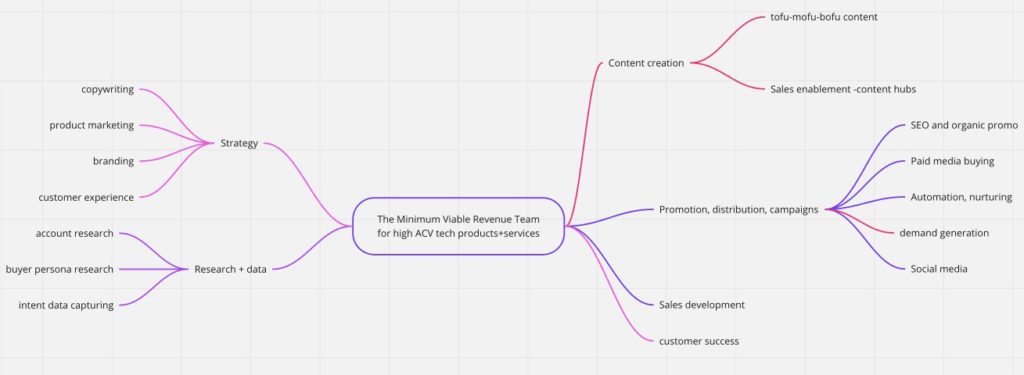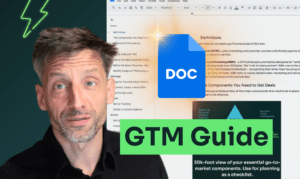Tech service companies and consultancies sometimes grow to $3M+ in revenue and 100+ people with very little marketing. There are some sales plays that can “make things work” initially without having a marketing engine. For example, selling to/through your network, getting referred can go a long way. These are nice ways to kickstart a company, but what happens when you want to scale growth? When you want to set up revenue operations? This episode is about how to add the structure and systems that will help scale growth, by building a marketing team.
When you combine the “low-hanging fruit” techniques with adequate branding, demand generation and a go to market strategy, they amplify results and put your revops on an unstoppable path.
The benefits of marketing… beyond getting more revenue
Good marketing is not only about revenue and growth – although that’s the greatest, most desired benefit. When your service company has clear positioning, messaging and a brand, some results are:
- Work only with the clients you want, only on the most enjoyable projects. After a while, you’ll even a waiting list of these perfect-fit clients – giving extra predictability and safety to growth.
- More efficient sales
- Easier to attract and retain talent
- More predictable growth (thought I’d mention this again)
- Less confusion, more confidence and consistent communication
- Increased company evaluation. As opposed to stone-hopping between one-off, unscalable guerilla tactics, having a documented growth engine that produces predictable results increases a company’s valuation big time.
This is a HUGE opportunity – you can create aligned, revenue-focused marketing that is perfectly synced with sales and smoke your competition with legacy marketing organizations.
If you have a proven product or service and haven’t yet started building a scalable growth engine, now is the time to start.
The three big areas and connecting the dots
Three big areas:
- Demand generation: putting out content that educates the market and makes them want to work with you – at all stages of the buying journey – including upselling existing clients.
- Branding: branding is not the logo, not the visual appearance, not the slide decks. It is the goodwill and sentiment around your company. It is the sum of interactions, experiences and which will get them to want to work with you. This goes for employees as well.
- Account-Based Marketing – go to market: how you create a list of dream accounts and target and engage them to become clients.
Mindset:
- Don’t think just marketing. Think marketing, sales and customer success. These three should go hand-in-hand and the lines between them often blur. This unified team of diverse customer-facing talent – all focused on revenue and driving customer experience is referred to as revenue operations or revops.
- Marketing and sales should really be aligned on what a quality lead is. Have the right metrics.
- Forget lead quantity. Organizations tend to trust in “many leads”. They have the assumption that once they have a bunch, all there is to do is weed out the buyers which is straightforward. Life doesn’t work that way: you need a small number of high quality leads.
- Make everything about customer experience. CX starts at the first interaction with a prospect. The way your marketing and sales flow is a huge part of customer experience.
Building a revenue/marketing department – what skills do you need?
Focusing on the marketing part of the revenue equation, we’ve distilled the skills you’ll need in a “minimum viable revenue team” for a high average customer lifetime value (ACV) technology company. (Click to see the whole thing.)

For most companies, unless you have a seasoned executive who has experience hiring and directing such a team, you’re better off hiring a fractional CMO/CRO or finding a growth partner to lead the way. Then you can gradually insource activities.
A B2B growth partner is ideally a strategy-minded consultancy with a strong, agile executional arm (aka, “agency”-arm). Their job is to create full-funnel growth experiments: figure out what avenues of revenue work for your company.
Make sure they have B2B and account-based marketing experience. B2B is its own game – different strategy, different tools, different ways to measure success. You can’t just figure things out as you go along. In fact, beware of the warning-signs of a poor B2B agency/partner.
Look for people who have walked the journey, not ones who have experience in the “destination”. For example, if you’re a $5M company looking to grow to $10M in the coming years, it may be tempting to hire an executive who has experience in $10+M companies. However, because they are used to different resources, budgets than what you have. Look for someone who has walked the journey that you are embarking on.
Bad news: there are no shortcuts. “We’ll just train juniors – put them through video courses… and they’ll get the hang of it.” The good news is that they really will. The bad news is that it’ll be slower than what you anticipate. No course or training makes up for on-the-job experience and mentoring.
Working with a consultancy will accelerate the process and end up saving you time, money and pain. The right growth partner is both a consultant and an agency, who is ready to hand over marketing revenue operations as you scale – and not try to tie themselves to your company. To learn about how Klear works and how we may be able to build your revenue operations, get in touch via the blue box below.
Related Posts
- SDR superpowers for account-based marketing - ep 8
Be'Anka Ashaolu, VP of Marketing at Propel and Dan from Klear dive-into some exciting parts…
- The simple B2B growth-marketing play - ep 3
Can you have success with almost zero marketing? Some believe it’s possible. Up to a…
- Better account-based marketing with digital events - ep 1
Webinars have been the thing for quite a few years. In Episode 1 of our…

